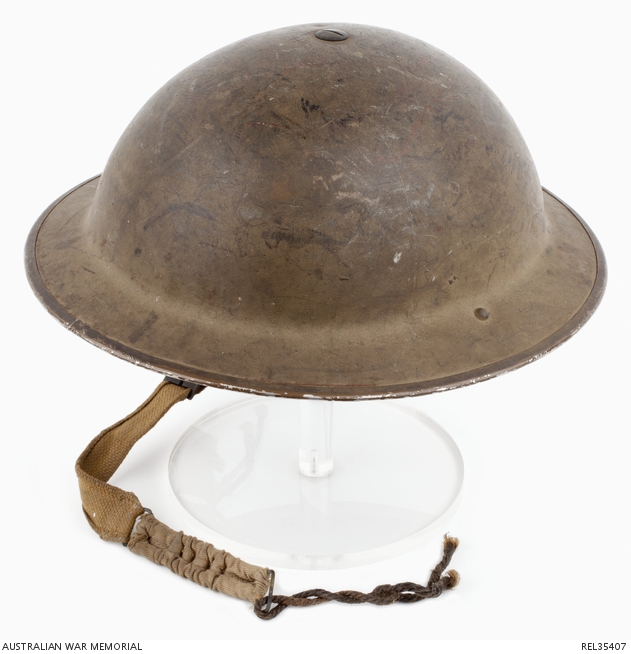| Places | |
|---|---|
| Accession Number | REL35407 |
| Collection type | Heraldry |
| Object type | Helmet |
| Physical description | Cotton webbing, Elastic, Rubber, Rubberised fabric, Steel |
| Maker |
Unknown |
| Place made | United Kingdom |
| Date made | 1940 |
| Conflict |
Second World War, 1939-1945 |
British MK II steel helmet : Lieutenant H R Syme, Royal Australian Naval Volunteer Reserve

British MK II steel helmet. The helmet is stamped into shape from sheet metal and has a rolled edge of sheet metal around the brim to cover the sharp edges. Inside the helmet, the liner is attached to the crown by one external screw through the top of the crown Beneath the screw the initials 'HRS' has been scratched. A cross shaped piece of rubber with a central hole cut into it surrounds the base of the screw inside the helmet. Four metal arms extend down from the crown of the helmet and are then attached to the metal rim of the liner. The arm at the front of the helmet has been stamped '7 1/4 / VERO / II / 1940'. The rim has then been covered with a rubberised fabric. This fabric has five flaps inside the crown which can be tightened and tied off with string to better fit the wearer's head. Rubber stoppers are fixed to the outer side of the liner to cushion the wearer's head against minor impacts.
Riveted to the left and right side of the helmet are hooks to which the chin strap is attached. The chin strap has a metal loop at each end which is then attached to the riveted hook inside the helmet. A piece of heavy twine has been tied to both metal loops on the chin strap. Both sides of the strap are made from an elasticised cotton fabric with metal loops at the bottom ends. To the left hand loop is attached a short piece of cotton webbing with a metal buckle. The right side of the strap has a longer piece of cotton webbing to pass under the wearer's chin and attach to the buckle. At the front of the helmet underneath the rim is scratched 'H R SYME'. Underneath the rim at the rear of the helmet has been stamped 'F & L BZ411 - 1940'.
Associated with the service of Lieutenant Hugh Randall Syme, Royal Australian Naval Volunteer Reserve (RANVR). Syme was born on 28 February 1903 at Kew, Melbourne. His father, John Herbert, was a journalist, and his son settled into the family business (they published 'The Age' newspaper) as assistant manager before the war. As a keen amateur sailor, the 6 foot tall Syme was accepted in the Royal Australian Naval Volunteer Reserve (RANVR) as part of the Yachtsman Scheme (whereby the Australian Naval Board provided personnel to the Admiralty via the RANVR).
He passed a navigation test and was appointed a probationary sub-lieutenant on 1 September 1940. Syme was soon mobilised to England and trained at HMS King Alfred. He was among the first group of Australians to be chosen to serve in the Rendering Mines Safe section and they received specialist training and were posted to HMS Vernon where the section was based.
Syme was promoted to lieutenant in mid December 1940. German bombing and air raids ensured the team had plenty of practice disarming unexploded mines and bombs. Syme rapidly developed a reputation for bravery, being awarded the George Cross and George Medal and bar for a string of successful mine recoveries. He is only one of eight people who have been awarded both the George Cross and George Medals for gallantry.
In January 1943 Syme returned to Australia following the deaths of his father and uncle, becoming temporary trustee of the family business. Despite his desire to return England, the RAN decided to keep him in Australia and utilise his expertise, setting him up in April 1943 at HMAS Cerberus as Commanding Officer of a bomb-disposal section. Little was asked of the section and Syme departed in December 1944, returning to the family business. In 1946 he was appointed general manager of 'The Age'. Syme returned to uniform briefly as part of Australia's Coronation Contingent in 1953. In 1948, Syme formed David Syme & Co. Ltd. He oversaw the company's entry into television in 1956 and was general manager until 1963. Syme was then director of the company until his death on 11 November 1965.
Related information
Conflicts
Places
Subjects
People
Related Objects
- PORTRAIT OF LIEUTENANT HUGH RANDALL SYME. GC., GM., AND BAR, ROYAL AUSTRALIAN NAVY VOLUNTEER ...
- PORTRAIT OF LIEUTENANT H. R. SYME, GC., GM AND BAR, ROYAL AUSTRALIAN NAVY VOLUNTEER RESERVE, WHO ...
- LIEUTENANT H.R. SYME, GC, GM AND BAR, OUTSIDE GOVERNMENT HOUSE AFTER RECEIVING THE GEORGE CROSS ...
- Radio 3TR program "50 and Over". Lieutenant Commander Hugh Randall Syme GC, GM and Bar talks about his experiences in mine disposal in the United Kingdom during the Second World War.
- George Cross: Lieutenant Hugh Randall Syme, RANVR
- George Medal and bar : Lieutenant H R Syme, RANVR
- Defence Medal : Lieutenant H R Syme, RANVR
- British War Medal 1939-45 : Lieutenant H R Syme, RANVR
- Australia Service Medal : Lieutenant H R Syme, RANVR
- Queen Elizabeth II Coronation Medal : Hugh Randall Syme